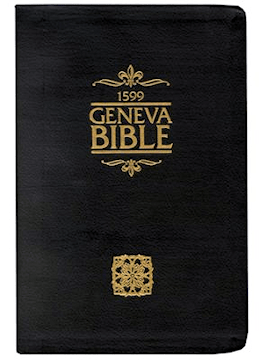Textus Receptus Bibles
Geneva Bible 1560/1599
| 27:1 | Moreouer thou shalt make the altar of Shittim wood, fiue cubites long and fiue cubites broade (the altar shall be foure square) and the height thereof three cubites. |
| 27:2 | And thou shalt make it hornes in the foure corners thereof: the hornes shalbe of it selfe, and thou shalt couer it with brasse. |
| 27:3 | Also thou shalt make his ashpannes for his ashes and his besoms, and his basens, and his flesh-hookes, and his censers: thou shalt make all the instruments thereof of brasse. |
| 27:4 | And thou shalt make vnto it a grate like networke of brasse: also vpon that grate shalt thou make foure brasen rings vpon the foure corners thereof. |
| 27:5 | And thou shalt put it vnder the compasse of the altar beneath, that the grate may be in the middes of the altar. |
| 27:6 | Also thou shalt make barres for the altar, barres, I say, of Shittim wood, and shalt couer them with brasse. |
| 27:7 | And the barres thereof shalbe put in the rings, the which barres shalbe vpon the two sides of the altar to beare it. |
| 27:8 | Thou shalt make the altar holowe betweene the boardes: as God shewed thee in the mount, so shall they make it. |
| 27:9 | Also thou shalt make the court of the Tabernacle in the Southside, euen full South: the court shall haue curtaines of fine twined linnen, of an hundreth cubites long, for one side, |
| 27:10 | And it shall haue twentie pillars, with their twentie sockets of brasse: the heades of the pillars, and their filets shalbe siluer. |
| 27:11 | Likewise on the Northside in length there shalbe hangings of an hundreth cubites long, and the twentie pillars thereof with their twentie sockets of brasse: the heades of the pillars and the filets shalbe siluer. |
| 27:12 | And the breadth of the court on the Westside shall haue curtaines of fiftie cubites, with their ten pillars and their ten sockets. |
| 27:13 | And the breadth of the court, Eastwarde full East shall haue fiftie cubites. |
| 27:14 | Also hangings of fifteene cubites shalbe on the one side with their three pillars and their three sockets. |
| 27:15 | Likewise on the other side shalbe hangings of fifteene cubites, with their three pillars and their three sockets. |
| 27:16 | And in the gate of the court shalbe a vaile of twentie cubites, of blewe silke, and purple, and skarlet, and fine twined linen wrought with needle, with the foure pillars thereof and their foure sockets. |
| 27:17 | All the pillars of the court shall haue filets of siluer round about, with their heads of siluer, and their sockets of brasse. |
| 27:18 | The length of the court shalbe an hundreth cubites, and the breadth fiftie at either ende, and the height fiue cubites, and the hangings of fine twined linen, and their sockets of brasse. |
| 27:19 | Al the vessels of the Tabernacle for al maner seruice thereof, and all the pinnes thereof, and all the pinnes of the court shalbe brasse. |
| 27:20 | And thou shalt commande the children of Israel, that they bring vnto thee pure oyle oliue beaten, for the light, that the lampes may alway burne. |
| 27:21 | In the Tabernacle of the Congregation without the vaile, which is before the Testimony, shall Aaron and his sonnes dresse them from euening to morning before the Lord, for a statute for euer vnto their generations, to be obserued by the children of Israel. |

Geneva Bible 1560/1599
The Geneva Bible is one of the most influential and historically significant translations of the Bible into English, preceding the King James translation by 51 years. It was the primary Bible of 16th century Protestantism and was the Bible used by William Shakespeare, Oliver Cromwell, John Knox, John Donne, and John Bunyan. The language of the Geneva Bible was more forceful and vigorous and because of this, most readers strongly preferred this version at the time.
The Geneva Bible was produced by a group of English scholars who, fleeing from the reign of Queen Mary, had found refuge in Switzerland. During the reign of Queen Mary, no Bibles were printed in England, the English Bible was no longer used in churches and English Bibles already in churches were removed and burned. Mary was determined to return Britain to Roman Catholicism.
The first English Protestant to die during Mary's turbulent reign was John Rogers in 1555, who had been the editor of the Matthews Bible. At this time, hundreds of Protestants left England and headed for Geneva, a city which under the leadership of Calvin, had become the intellectual and spiritual capital of European Protestants.
One of these exiles was William Whittingham, a fellow of Christ Church at Oxford University, who had been a diplomat, a courtier, was much traveled and skilled in many languages including Greek and Hebrew. He eventually succeeded John Knox as the minister of the English congregation in Geneva. Whittingham went on to publish the 1560 Geneva Bible.
This version is significant because, it came with a variety of scriptural study guides and aids, which included verse citations that allow the reader to cross-reference one verse with numerous relevant verses in the rest of the Bible, introductions to each book of the Bible that acted to summarize all of the material that each book would cover, maps, tables, woodcut illustrations, indices, as well as other included features, all of which would eventually lead to the reputation of the Geneva Bible as history's very first study Bible.